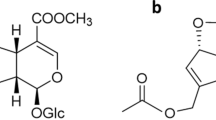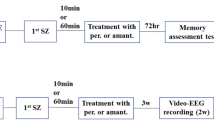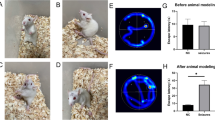Abstract
Objective
To investigate the neuromodulatory effect of pinellia total alkaloids (PTA) on the gamma-aminobutyric acidergic (GABAergic) system in epileptic rats, and preliminarily evaluate the anti-epileptic effect of PTA.
Methods
Ninety-one male Sprague-Dawley rats were randomized to a control group (n=17) or an epileptic group (n=74) using computer-generated random numbers. Status epilepticus (SE) was induced with pilocarpine in the epileptic group. Epileptic rats that survived SE were randomly divided into 4 groups, namely an epilepsy group (n=13), a topiramate (TPM, 60 mg/kg) group (n=12), a high-dose PTA (800 mg/kg) group (n=12), and a low-dose PTA (400 mg/kg) group (n=10). Treatments were given intragastrically once daily for 14 days. The control group and epilepsy group received normal saline. Spontaneous recurrent seizures (SRSs) were monitored 8-h daily for 7 days after treatment. Then, the hippocampal formation tissues were collected. GABA level was measured using enzyme-linked immunosorbent assay. Protein and mRNA expression levels of glutamate decarboxylase 65 (GAD65), GABA transporter-1 (GAT-1), GABA transaminase (GABA-T), and GABAA receptor (GABAAR) α4, α5, γ2 and δ subunits were measured using Western-blotting analysis and quantitative polymerase chain reaction.
Results
PTA lowered the incidence and frequency of SRS (both doses vs. the TPM group, P>0.05). Compared with the epilepsy group, PTA increased the levels of GABA (both doses P<0.01) and GAD65 (mRNA, 800 mg/kg, P<0.01), and suppressed the levels of GAT-1 (mRNA, 800 mg/kg, P<0.01; 400 mg/kg, P<0.05), GABA-T (mRNA, both doses P<0.01), and GABAAR δ subunit (protein, 800 mg/kg, P<0.05) and γ2 subunit (protein, both doses P<0.01). PTA upregulated the low-expressed mRNA levels of GABAAR α5 subunit (400 mg/kg, P<0.01), δ subunit (800 mg/kg, P<0.05), and γ2 subunit (400 mg/kg, P<0.05).
Conclusions
PTA regulated the GABAergic system through modulating GABA levels and the expression levels of GAD65, GAT-1, GABA-T, and GABAAR α4, α5, γ2 and δ subunits. PTA may exert anti-epileptic effects on the pilocarpine-induced epilepsy model.
Similar content being viewed by others
References
Cheng YX, Wang MZ, Chen JJ, Yang R, He XG, Ma YG, et al. Synergistic effect of pinellia total alkaloids and uncaria total alkaloids on anticonvulsant action in mice and rats. Chin Pharmacol J 2007;2:139–145.
Ma YG. The effect of pinellia total alkaloids on EcoG, CEP, and cerebral GABA, Glu receptor in epileptic rats. Master’s thesis [Dissertation]. Taiyuan: Shanxi Medical University, 2007:1–35.
Gu YT, Ma YG, Wang MZ, Wang XF, Xiao Y. The effect of pinellia total alkaloids on the amino acid concentration and the GABAA receptor expression in hippocampus region of epileptic rats. Chin Pharmacol J 2009;3:252–256.
Gonzalez MI, Grabenstatter HL, Cea-Del Rio CA, Cruz Del Angel Y, Carlsen J, Laoprasert RP, et al. Seizure-related regulation of GABAA receptors in spontaneously epileptic rats. Neurobiol Dis 2015;77:246–256.
Zhang R, Yang YS, Liu XC, Yang JL, Li YH, Shi PZ, et al. Correlation study of basic Chinese medicine syndromes and neurotransmitter levels in patients with primary insomnia. Chin J Integr Med, 2016. https://doi.org/10.1007/s11655-016-2752-2
Cai Q, Wang HW, Hua SY, Tan JZ, Zhou T, Li CS. Neutroprotective efficacy of sodium tanshinone B on hippocampus neuron in a rat model of focal cerebral ischemia. Chin J Integr Med 2012;18:837–845.
Walls AB, Nilsen LH, Eyjolfsson EM, Vestergaard HT, Hansen SL, Schousboe A, et al. GAD65 is essential for synthesis of GABA destined for tonic inhibition regulating epileptiform activity. J Neurochem 2010;115:1398–1408.
Schousboe A, Madsen KK, White HS. GABA transport inhibitors and seizure protection: the past and future. Future Med Chem 2011;3:183–187.
Pearl PL, Gibson KM, Cortez MA, Wu Y, Carter Snead III O, Knerr I, et al. Succinic semialdehyde dehydrogenase deficiency: lessons from mice and men. J Inherit Metab Dis 2009;32:343–352.
Gey L, Gernert M, Loscher W. Continuous bilateral infusion of vigabatrin into the subthalamic nucleus: effects on seizure threshold and GABA metabolism in two rat models. Neurobiol Dis 2016;91:194–208.
Lasoñ W, Chlebicka M, Rejdak K. Research advances in basic mechanisms of seizures and antiepileptic drug action. Pharmacol Rep 2013;65:787–801.
Walker MC, Kullmann DM. Tonic GABAA receptor-mediated signaling in epilepsy. In: Noebels JL, Avoli M, Rogawski MA, eds. Jasper’s basic mechanisms of the epilepsies. 4th ed. Bethesda (MD): National Center for Biotechnology Information (US);2012:147–162.
Curia G, Longo D, Biagini G, Jones RS, Avoli M. The pilocarpine model of temporal lobe epilepsy. J Neurosci Methods 2008;172:143–157.
Brandt C, Tollner K, Klee R, Broer S, Löscher W. Effective termination of status epilepticus by rational polypharmacy in the lithium-pilocarpine model in rats: window of opportunity to prevent epilepsy and prediction of epilepsy by biomarkers. Neurobiol Dis 2015;75:78–90.
Racine R. Modification of seizure activity by electrical stimulation. II. Motor seizure. Electroencephalogr Clin Neurophysiol 1972;32:281–294.
Glien M, Brandt C, Potschka H, Voigt H, Ebert U, Löscher W. Repeated low-dose treatment of rats with pilocarpine: low mortality but high proportion of rats developing epilepsy. Epilepsy Res 2001;46:111–119.
Furtado MA, Castro OW, Del Vecchio F, de Oliveira JA, Garcia-Cairasco N. Study of spontaneous recurrent seizures and morphological alterations after status epilepticus induced by intrahippocampal injection of pilocarpine. Epilepsy Behav 2011;20:257–266.
Reddy DS, Kuruba R. Experimental models of status epilepticus and neuronal injury for evaluation of therapeutic interventions. Int J Mol Sci 2013;14:18284–18318.
Scorza FA, Arida RM, Naffah-Mazzacoratti Mda G, Scerni DA, Calderazzo L, Cavalheiro EA. The pilocarpine model of epilepsy: what have we learned? An Acad Bras Cienc 2009;81:345–365.
Löscher W, Brandt C. Prevent ion or modification of epileptogenesis after brain insults: experimental approaches and translational research. Pharmacol Rev 2010;62:668–700.
Mathew J, Balakrishnan S, Antony S, Abraham PM, Paulose CS. Decreased GABA receptor in the cerebral cortex of epileptic rats: effect of Bacopa monnieri and bacoside-A. J Biomed Sci 2012;19:25.
Wang JG, Cai Q, Zheng J, Dong YS, Li JJ, Li JC, et al. Epigenetic suppression of GADs expression is involved in temporal lobe epilepsy and pilocarpine-induced mice epilepsy. Neurochem Res 2016;41:1751–1760.
Cherubini E. Phasic GABAA-mediated inhibition. In: Noebels JL, Avoli M, Rogawski MA, eds. Jasper’s Basic Mechanisms of the Epilepsies. 4th ed. Bethesda (MD): National Center for Biotechnology Information (US);2012:127–146.
Li ZX, Yu HM, Jiang KW. Tonic GABA inhibition in hippocampal dentate granule cells: its regulation and function in temporal lobe epilepsies. Acta Physiol (Oxf) 2013;209:199–211.
Houser CR, Zhang N, Peng Z. Alterations in the distribution of GABAA receptors in epilepsy. In: Noebels JL, Avoli M, Rogawski MA, ed. Jasper’s Basic Mechanisms of the Epilepsies. 4th ed. Bethesda (MD): National Center for Biotechnology Information (US);2012:793–812.
Seo S, Leitch B. Synaptic changes in GABAA receptor expression in the thalamus of the stargazer mouse model of absence epilepsy. Neuroscience 2015;306:28–38.
Scharfman HE, Brooks-Kayal AR. Is plasticity of GABAergic mechanisms relevant to epileptogenesis? Adv Exp Med Biol 2014;813:133–150.
Gedeon T, Bokes P. Delayed protein synthesis reduces the correlation between mRNA and protein fluctuations. Biophys J 2012;103:377–385.
Maier T, Güell M, Serrano L. Correlation of mRNA and protein in complex biological samples. FEBS Lett 2009;583:3966–3973.
Vogel C, Marcotte EM. Insights into the regulation of protein abundance from proteomic and transcriptomic analyses. Nat Rev Genet 2012;13:227–232.
Author information
Authors and Affiliations
Contributions
Deng CX wrote the manuscript. Deng CX and Wu ZB designed the study. Deng CX and Chen Y conducted the experiments. Deng CX, Wu ZB, and Yu ZM conducted the data analysis. All authors read and approved the manuscript.
Corresponding author
Ethics declarations
All authors have no conflict of interest to disclose.
Rights and permissions
About this article
Cite this article
Deng, Cx., Wu, Zb., Chen, Y. et al. Pinellia Total Alkaloids Modulate the GABAergic System in Hippocampal Formation on Pilocarpine-Induced Epileptic Rats. Chin. J. Integr. Med. 26, 138–145 (2020). https://doi.org/10.1007/s11655-019-2944-7
Accepted:
Published:
Issue Date:
DOI: https://doi.org/10.1007/s11655-019-2944-7




